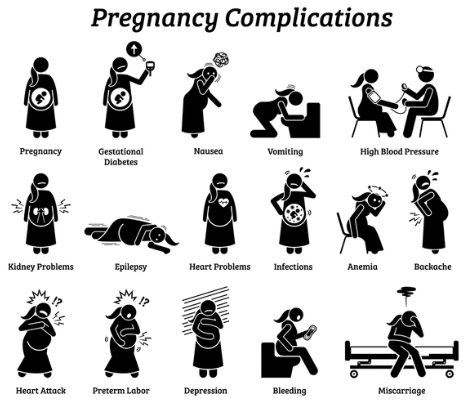Labor is a significant and exciting time in pregnancy, but it can sometimes be accompanied by complications that require careful management to ensure the safety and well-being of both mother and baby. Being aware of potential labor complications and understanding how they are managed can help you prepare for a smoother labor experience. Here’s an overview of common labor complications, their potential impacts, and what you can do to address them. Some Common Complications include:
Prolonged Labor:
- Definition: Labor that lasts significantly longer than expected. First-time mothers often experience prolonged labor, defined as more than 18 to 24 hours, while subsequent deliveries may exceed 12 hours.
- Causes: Factors such as weak contractions, the baby’s position, or a large baby can contribute to prolonged labor.
- Management: Your healthcare provider may recommend interventions such as labor augmentation with medications (e.g., oxytocin) or changes in labor positions to help progress.
Fetal Distress:
- Definition: Signs that the baby may not be getting enough oxygen or is experiencing stress during labor.
- Causes: Fetal distress can result from umbilical cord compression, uterine contractions that are too strong, or placental insufficiency.
- Management: Continuous fetal monitoring helps detect distress early. If fetal distress is identified, your provider may adjust your labor management, such as changing your position or providing supplemental oxygen. In severe cases, a cesarean section (C-section) may be necessary.
Uterine Rupture:
- Definition: A tear in the uterus that can occur during labor, particularly in women with a previous C-section or uterine surgery.
- Symptoms: Symptoms include sudden severe abdominal pain, vaginal bleeding, and changes in fetal heart rate.
- Management: Uterine rupture is a medical emergency that requires immediate attention. A C-section is often performed to address the rupture and ensure the safety of both mother and baby.
Shoulder Dystocia:
- Definition: A complication where the baby’s shoulder gets stuck behind the mother’s pelvic bone during delivery.
- Symptoms: Shoulder dystocia can cause prolonged labor and difficulty in delivering the baby’s shoulders.
- Management: Techniques such as the McRoberts maneuver (flexing the mother’s knees towards her chest) or the use of specific delivery positions can help resolve shoulder dystocia. In some cases, additional medical interventions may be required.
Excessive Bleeding (Postpartum Hemorrhage):
- Definition: Excessive bleeding after the delivery of the baby, typically defined as losing more than 500 ml of blood after a vaginal delivery or 1,000 ml after a C-section.
- Causes: Causes include uterine atony (failure of the uterus to contract), retained placenta, or tears in the birth canal.
- Management: Immediate treatment focuses on controlling bleeding through medications that help the uterus contract, manual removal of retained placenta, and addressing any tears or lacerations. Blood transfusions may be necessary in severe cases.

Preparing for and Managing Complications
- Prenatal Education: Attend childbirth education classes to learn about the labor process and potential complications. Understanding what to expect can help reduce anxiety and prepare you for various scenarios.
- Open Communication: Discuss your birth plan and any concerns with your healthcare provider ahead of time. Being informed about potential complications and having a plan in place can make it easier to handle unexpected situations.
- Monitoring and Support: During labor, your healthcare team will continuously monitor both you and your baby. Trust their expertise and follow their guidance to manage any complications that may arise.
- Flexibility: Be prepared for adjustments to your birth plan based on real-time conditions. Flexibility can help ensure that both you and your baby receive the best possible care during labor.
Conclusion: While complications during labor can be concerning, understanding potential issues and having a plan for managing them can help ensure a safer delivery. By staying informed, communicating openly with your healthcare provider, and being prepared to adapt, you can contribute to a positive labor experience. If you have any concerns or questions about labor and potential complications, don’t hesitate to discuss them with your healthcare team for personalized guidance and support.

